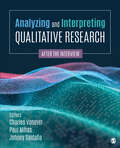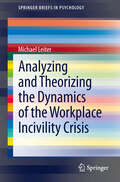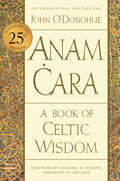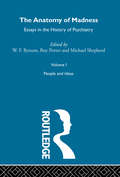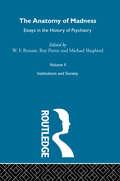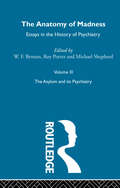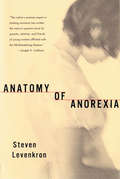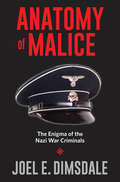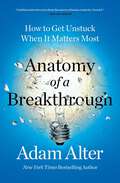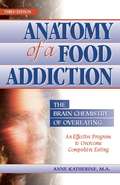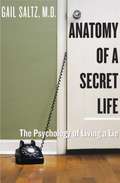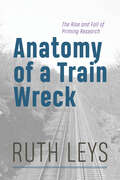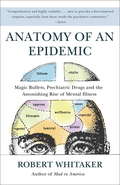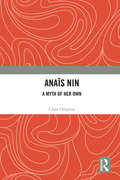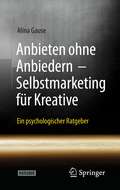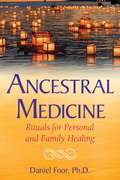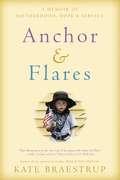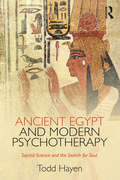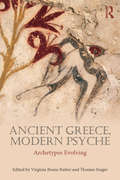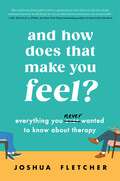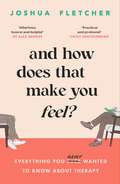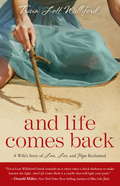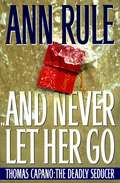- Table View
- List View
Analyzing and Interpreting Qualitative Research: After the Interview
by Johnny Saldaña Charles Vanover Paul MihasThis text provides comprehensive coverage of the key methods for analyzing, interpreting, and writing up qualitative research in a single volume, and drawing on the expertise of major names in the field. Covering all the steps in the process of analyzing, interpreting, and presenting findings in qualitative research, the authors utilize a consistent chapter structure that provides novice and seasoned researchers with pragmatic, "how-to" strategies. Each chapter introduces the method; uses one of the authors′ own research projects as a case study of the method described; shows how the specific analytic method can be used in other types of studies; and concludes with questions and activities to prompt class discussion or personal study.
Analyzing and Interpreting Qualitative Research: After the Interview
by Johnny Saldaña Charles Vanover Paul MihasThis text provides comprehensive coverage of the key methods for analyzing, interpreting, and writing up qualitative research in a single volume, and drawing on the expertise of major names in the field. Covering all the steps in the process of analyzing, interpreting, and presenting findings in qualitative research, the authors utilize a consistent chapter structure that provides novice and seasoned researchers with pragmatic, "how-to" strategies. Each chapter introduces the method; uses one of the authors′ own research projects as a case study of the method described; shows how the specific analytic method can be used in other types of studies; and concludes with questions and activities to prompt class discussion or personal study.
Analyzing and Theorizing the Dynamics of the Workplace Incivility Crisis (SpringerBriefs in Psychology #8)
by Michael LeiterContemporary worklife builds upon a foundation for teamwork among skilled and dedicated people. Despite the utility of supportive working relationships and despite extensive consulting activity on leadership and team building, employees complain extensively about mistreatment by their bosses and colleagues. Analyzing and Theorizing the Dynamics of the Workplace Incivility Crisis presents a theoretic framework for considering the fundamental issues of group dynamics and individual psychology that lie behind this ongoing workplace incivility crisis. It contextualizes the need for belonging as a motivation that shapes expressed social behaviour and intensifies received social behaviour. Looking at cognitive elements as well as rudeness rationales that pertain to workplace incivility and its justification, this work maps social constructs, including the role of team leadership, that lead to setting implicit social norms. In addition to formulating a theoretical framework, Analyzing and Theorizing the Dynamics of the Workplace Incivility Crisis considers methods to address the dynamics that perpetuate incivility at work and actively points at setting an action agenda to evaluate their impact.
Anam Cara [Twenty-fifth Anniversary Edition]: A Book of Celtic Wisdom
by John O'Donohue“In this twenty-fifth anniversary edition, you will find John a “soul friend” on your own journey through life, offering support and solace, clarity, and consciousness—expanding narratives that invite you to experience relationships with people, nature, and even your inner world in new ways that nurture well-being and resilience in these challenging times.” —Daniel J. Siegel, MD, Neuropsychiatrist and New York Times Bestselling AuthorA special twenty-fifth anniversary edition of the classic work of Celtic spirituality and mysticism by beloved poet and philosopher, John O'Donohue, with a new introduction by the President of Ireland, Michael D. Higgins, an afterword by the late author’s brother, Pat O'Donohue, and insightful material from O'Donohue's circle of close friends.In this revered classic, John O’Donohue excavates themes of friendship, belonging, solitude, creativity and the imagination, among many others. Widely recognized for bringing Celtic spirituality into modern dialogue, his unique insights from the ancient world speak with urgency for our need to rediscover the thresholds of the soul. With lyrical wisdom and fluency, O'Donohue encourages pathways of discovery to come home to the natural rhythm in ourselves in sacred connection with one another and the landscapes we inhabit. This timeless collection nourishes the heart and elevates the spirit. It is "a book to read and reread forever.” (Irish Times)
Anatomy Of Madness Vol 1: People And Ideas (Routledge Library Editions Ser.)
by Roy Porter Michael Shepherd W F BynumFirst Published in 2004. Routledge is an imprint of Taylor & Francis, an informa company.
Anatomy Of Madness Vol 2: People And Ideas (Routledge Library Editions Ser.)
by Roy Porter Michael Shepherd W F BynumFirst Published in 2004. Routledge is an imprint of Taylor & Francis, an informa company.
Anatomy Of Madness Vol 3: People And Ideas (Routledge Library Editions Ser.)
by Roy Porter Michael Shepherd W F BynumFirst Published in 2004. Routledge is an imprint of Taylor & Francis, an informa company.
Anatomy of Anorexia
by Steven Levenkron"Invaluable to clinicians, parents, teenagers, and adults who are struggling with anorexia." —Lynn E. Ponton, M.D. Anatomy of Anorexia is a tremendous tool for families: now more than ever, early diagnosis and treatment, and family participation, are crucial in helping the anorexic. Preeminent therapist Steven Levenkron demystifies this life-threatening disease and shows how the millions of girls and women who are afflicted with anorexia can be helped—and can look forward to rich and productive lives. "The nation’s premier expert in treating anorexia has written the nation’s premier book for parents, relatives, and friends of young women afflicted with this life-threatening disease."—Joseph A. Califano Jr., president of the National Center on Addiction and Substance Abuse at Columbia University and former U.S. Secretary of Health, Education, and Welfare "[Levenkron’s] insights, descriptions of family relationships, and treatment recommendations for therapists create a rich, deep, and most helpful guide for a community of people whose lives are deeply and painfully affected by this persistent illness."—Samuel C. Klagsbrun, M.D.
Anatomy of Malice: The Enigma of the Nazi War Criminals
by Joel E. DimsdaleAn eminent psychiatrist delves into the minds of Nazi leadershipin &“a fresh look at the nature of wickedness, and at our attempts to explain it&” (Sir Simon Wessely, Royal College of Psychiatrists). When the ashes had settled after World War II and the Allies convened an international war crimes trial in Nuremberg, a psychiatrist, Douglas Kelley, and a psychologist, Gustave Gilbert, tried to fathom the psychology of the Nazi leaders, using extensive psychiatric interviews, IQ tests, and Rorschach inkblot tests. The findings were so disconcerting that portions of the data were hidden away for decades and the research became a topic for vituperative disputes. Gilbert thought that the war criminals&’ malice stemmed from depraved psychopathology. Kelley viewed them as morally flawed, ordinary men who were creatures of their environment. Who was right? Drawing on his decades of experience as a psychiatrist and the dramatic advances within psychiatry, psychology, and neuroscience since Nuremberg, Joel E. Dimsdale looks anew at the findings and examines in detail four of the war criminals, Robert Ley, Hermann Göring, Julius Streicher, and Rudolf Hess. Using increasingly precise diagnostic tools, he discovers a remarkably broad spectrum of pathology. Anatomy of Malice takes us on a complex and troubling quest to make sense of the most extreme evil. &“In this fascinating and compelling journey . . . a respected scientist who has long studied the Holocaust asks probing questions about the nature of malice. I could not put this book down.&”—Thomas N. Wise, MD, Johns Hopkins University School of Medicine &“This harrowing tale and detective story asks whether the Nazi War Criminals were fundamentally like other people, or fundamentally different.&”—T.M. Luhrmann, author of How God Becomes Real
Anatomy of a Breakthrough: How to Get Unstuck When It Matters Most
by Adam AlterA groundbreaking guide to breaking free from the thoughts, habits, jobs, relationships, and even business models that prevent us from achieving our full potential.Almost everyone feels stuck in some way. Whether you&’re muddling through a midlife crisis, wrestling writer&’s block, trapped in a thankless job, or trying to remedy a fraying friendship, the resulting emotion is usually a mix of anxiety, uncertainty, fear, anger, and numbness. But it doesn&’t have to be this way. Anatomy of a Breakthrough is the roadmap we all need to escape our inertia and flourish in the face of friction. Adam Alter has spent the past two decades studying how people become stuck and how they free themselves to thrive. Here he reveals the formula he and other researchers have uncovered. The solution rests on a process that he calls a friction audit—a systematic procedure that uncovers why a person or organization is stuck, and then suggests a path to progress. The friction audit states that people and organizations get unstuck when they overcome three sources of friction: HEART (unhelpful emotions); HEAD (unhelpful patterns of thought); and HABIT (unhelpful behaviors). Despite the ubiquity of friction, there are many great &“unstickers&” hidden in plain sight among us and Alter shines a light on some exceptional stories to share their valuable lessons with us. He tells us about the sub-elite swimmer who unstuck himself twice to win two Olympic gold medals, the actor who faced countless rejections before gaining worldwide fame, the renowned painter who became paralyzed and had to relearn to paint with a brush strapped to his wrist, and Alter&’s own story of getting unstuck from a college degree that made him deeply unhappy. Artfully weaving together scientific studies, anecdotes, and interviews, Alter teaches us that getting stuck is a feature rather than a glitch on the road to thriving, but with the right tweaks and corrections we can reach even our loftiest targets.
Anatomy of a Food Addiction
by Anne Katherine, M.A.If you have struggled with compulsive eating, dieting, and the guilt and conflict they bring, your life will be changed by this important, life-affirming, and astonishingly wise book. Anne Katherine, a Certified Eating Disorders Therapist and former compulsive eater, explains the chemical reactions in the brain that work in conjunction with lifelong emotional conflicts to make food--particularly sugar and refined carbohydrates--such a comfort that it's almost like a drug. Once you realize that your binge eating is a physical disease that can be treated, you can use the book's self-tests, exercises, examination of family issues, and complete recovery program for newfound understanding and confidence.
Anatomy of a Secret Life
by Gail SaltzWhat do these people have in common? • The traveling businessman who brings prostitutes back to his hotel room • The wealthy woman who is arrested for shoplifting • The seemingly happily married man who cruises gay clubs They are all—despite differences in degree, gender, and age—living a double life, one of our most deeply ingrained, but poorly understood psychological drives. Now, Dr. Gail Saltz steps into the breach to explore —in detail and based on the latest research—our impulse to create and nurture alter egos. Saltz reveals how assuming a different identity can be healthy and tremendously liberating. For proof, we need look no further than the innumerable people who reinvent themselves by moving to the big city, or the countless pseudonymous bloggers. But, as she also makes clear, leading a secret life comes with potentially serious psychological risks. She shows that, in more extreme cases, leading a secret life can have devastating emotional, social and familial consequences—both for the person leading the secret life, and for those close to him or her. The definitive popular work on how a secret life is formed, lived, justified, and exposed, Saltz’sAnatomyincludes contemporary case studies and historical examples (Lindbergh, T. E. Lawrence, Tchaikovsky, et cetera) of people who have risked it all for a taste of forbidden fruit.
Anatomy of a Train Wreck: The Rise and Fall of Priming Research
by Ruth LeysA history of “priming” research that analyzes the field’s underlying assumptions and experimental protocols to shed new light on a contemporary crisis in social psychology. In 2012, a team of Belgian scientists reported that they had been unable to replicate a canonical experiment in the field of psychology known as “priming.” The original experiment, performed by John Bargh in the nineties, had purported to show that words connoting old age unconsciously influenced—or primed—research subjects, causing them to walk more slowly. When subsequent researchers could not replicate these results, Nobel-winning psychologist Daniel Kahneman warned of a “train wreck looming” if Bargh and his colleagues could not address doubts about their work. Since then, the inability to replicate other well-known priming experiments has helped precipitate an ongoing debate over what has gone wrong in psychology, raising fundamental questions about the soundness of research practices in the field. Anatomy of a Train Wreck offers the first detailed history of priming research from its origins in the early 1980s to its recent collapse. Ruth Leys places priming experiments in the context of contemporaneous debates over not only the nature of automaticity but also the very foundations of social psychology. While these latest discussions about priming have largely focused on methodology—including sloppy experimental practices, inadequate statistical methods, and publication bias—Leys offers a genealogy of the theoretical expectations and scientific paradigms that have guided and motivated priming research itself. Examining scientists’ intellectual strategies, their responses to criticism, and their assumptions about the nature of subjectivity, Anatomy of a Train Wreck raises crucial questions about the evidence surrounding unconscious influence and probes the larger stakes of the replication crisis: psychology’s status as a science.
Anatomy of an Epidemic: Magic Bullets, Psychiatric Drugs, and the Astonishing Rise of Mental Illness in America
by Robert WhitakerIn this astonishing and startling book, award-winning science and history writer Robert Whitaker investigates a medical mystery: Why has the number of disabled mentally ill in the United States tripled over the past two decades? Every day, 1,100 adults and children are added to the government disability rolls because they have become newly disabled by mental illness, with this epidemic spreading most rapidly among our nation’s children. What is going on?<P><P> Anatomy of an Epidemic challenges readers to think through that question themselves. First, Whitaker investigates what is known today about the biological causes of mental disorders. Do psychiatric medications fix “chemical imbalances” in the brain, or do they, in fact, create them? Researchers spent decades studying that question, and by the late 1980s, they had their answer. Readers will be startled—and dismayed—to discover what was reported in the scientific journals.<P> Then comes the scientific query at the heart of this book: During the past fifty years, when investigators looked at how psychiatric drugs affected long-term outcomes, what did they find? Did they discover that the drugs help people stay well? Function better? Enjoy good physical health? Or did they find that these medications, for some paradoxical reason, increase the likelihood that people will become chronically ill, less able to function well, more prone to physical illness? <P> This is the first book to look at the merits of psychiatric medications through the prism of long-term results. Are long-term recovery rates higher for medicated or unmedicated schizophrenia patients? Does taking an antidepressant decrease or increase the risk that a depressed person will become disabled by the disorder? Do bipolar patients fare better today than they did forty years ago, or much worse? When the National Institute of Mental Health (NIMH) studied the long-term outcomes of children with ADHD, did they determine that stimulants provide any benefit? <P> By the end of this review of the outcomes literature, readers are certain to have a haunting question of their own: Why have the results from these long-term studies—all of which point to the same startling conclusion—been kept from the public? <P> In this compelling history, Whitaker also tells the personal stories of children and adults swept up in this epidemic. Finally, he reports on innovative programs of psychiatric care in Europe and the United States that are producing good long-term outcomes. Our nation has been hit by an epidemic of disabling mental illness, and yet, as Anatomy of an Epidemic reveals, the medical blueprints for curbing that epidemic have already been drawn up.
Anaïs Nin: A Myth of Her Own
by Clara OropezaAnaïs Nin: A Myth of Her Own traces Nin’s literary craft by following the intimacy of self-exploration and poetic expression attained in the details of the quotidian, transfigured into fiction. By digging into the mythic tropes that permeate both her literary diaries and fiction, this book demonstrates that Nin constructed a mythic method of her own, revealing the extensive possibilities of an opulent feminine psyche. Clara Oropeza demonstrates that the literary diary, for Nin, is a genre that with its traces of trickster archetype, among others, reveals a mercurial, yet particular understanding of an embodied and at times mystical experience of a writer. The cogent analysis of Nin’s fiction alongside the posthumously published unexpurgated diaries, within the backdrop of emerging psychological theories, further illuminates Nin’s contributions as an experimental and important modernist writer whose daring and poetic voice has not been fully appreciated. By extending research on diary writing and anchoring Nin’s literary style within modernist traditions, this book contributes to the redefinition of what literary modernism was comprised, who participated and how it was defined. Anaïs Nin: A Myth of Her Own is unique in its interdisciplinary expansion of literature, literary theory, mythological studies and depth psychology. By considering the ecocritical aspects of Nin’s writing, this book forges a new paradigm for not only Nin’s work, but for critical discussions of self-life writing as a valid epistemological and aesthetic form. This impressive work will be of great interest to academics and students of Jungian and post-Jungian studies, literary studies, cultural studies, mythological studies and women’s studies.
Anbieten ohne Anbiedern - Selbstmarketing für Kreative: Ein psychologischer Ratgeber
by Alina GauseDieser Ratgeber hilft Menschen in kreativen Berufen bzw. mit kreativem Berufsziel, "sich selbst besser zu verkaufen". Er verspricht den Aufbau einer nachhaltigen Strategie, indem sowohl persönliche und künstlerische als auch Marketing-Aspekte berücksichtigt werden. Das Fundament bildet die Aufarbeitung der besonderen psychologischen Hürden, denen kreative Persönlichkeiten bei der Eigenwerbung gegenüber stehen. Darauf aufbauend führen praktische, individuelle Übungen hin zu einem persönlichen Leitfaden. Zahlreiche Fallbeispiele bieten zudem einen Einblick in ihre Erfahrungen ab. Sänger, Schauspieler, Szenografen, Regisseure, Autoren, Musiker und bildende Künstler dürfen sich davon ebenso angesprochen fühlen wie Köche, Designer oder andere kreative Seelen. Selbstmarketing kann Spaß machen. Und Spaß ist der einzige Treibstoff, der Kreative überzeugt. Nicht im Sinne von kurzem Kick oder leichter Unterhaltung, sondern von Erfüllung, visionärer Sinnhaftigkeit und Flow-Erlebnis. Nicht weniger als das dürfen die Leser dieses Buches erwarten.
Ancestral Medicine: Rituals for Personal and Family Healing
by Daniel FoorA practical guide to connecting with your ancestors for personal, family, and cultural healing• Provides exercises and rituals to help you initiate contact with your ancestors, find ancestral guides, and assist the dead who are not yet at peace• Explains how to safely engage in lineage repair work by connecting with your more ancient ancestors before relating with the recently deceased• Explores how your ancestors can help you transform intergenerational legacies of pain and abuse and reclaim the positive spirit of the familyEveryone has loving and wise ancestors they can learn to invoke for support and healing. Coming into relationship with your ancestors empowers you to transform negative family patterns into blessings and encourages good health, self-esteem, clarity of purpose, and better relationships with your living relatives. Offering a practical guide to understanding and navigating relationships with the spirits of those who have passed, Daniel Foor, PhD, details how to relate safely and effectively with your ancestors for personal, family, and cultural healing. He provides exercises and rituals, grounded in ancient wisdom traditions, to help you initiate contact with your ancestors, find supportive ancestral guides, cultivate forgiveness and gratitude, harmonize your bloodlines, and assist the dead who are not yet at peace. He explains how to safely engage in lineage repair work by connecting with your more ancient ancestors before relating with the recently deceased. He shows how, by working with spiritually vibrant ancestors, individuals and families can understand and transform intergenerational patterns of pain and abuse and reclaim the full blessings and gifts of their bloodlines. Ancestral repair work can also catalyze healing breakthroughs among living family members and help children and future generations to live free from ancestral burdens. The author provides detailed instructions for ways to honor the ancestors of a place, address dream visits from the dead, and work with ancestor shrines and altars. The author offers guidance on preparing for death, funeral rites, handling the body after death, and joining the ancestors. He also explains how ancestor work can help us to transform problems such as racism, sexism, homophobia, and religious persecution.By learning the fundamentals of ancestor reverence and ritual, you will discover how to draw on the wisdom of supportive ancestral guides, heal family troubles, maintain connections with beloved family after their death, and better understand the complex and interconnected relationship between the living and the dead.
Anchor and Flares: A Memoir of Motherhood, Hope, and Service
by Kate BraestrupKate Braestrup's life was transformed by the loss of her husband; now Kate faces the possibility that she may lose her son.As a young mother Kate Braestrup discovered the fierce protectiveness that accompanies parenthood. In the intervening years--through mourning her husband and the joy of remarriage and a blended family-Kate has absorbed the rewards and complications of that spirit. But when her eldest son joins the Marines, Kate is at a crossroads: Can she reconcile her desire to protect her children with her family's legacy of service? Can parents balance the joy of a child's independence with the fear of letting go? As Kate examines the twinned emotions of faith and fear-inspired by the families she meets as a chaplain and by her son's journey towards purpose and familyhood-she learns that the threats we can't predict will rip us apart and knit us together.
Ancient Egypt and Modern Psychotherapy: Sacred Science and the Search for Soul
by Todd HayenIn Ancient Egypt and Modern Psychotherapy, Todd Hayen explores what the spiritual concepts of the enigmatic ancient Egyptians can teach us about our own modern psyches and the pursuit of a meaningful life. Hayen examines the ancient Egyptians’ possession of a concept contemporary academics have labeled "consciousness of the heart": an innate knowledge of the entirety of the universe. While all human beings possess this consciousness of the heart, our modern culture has largely lost the ability to tap into this inborn knowledge. By examining the material accomplishments of ancient Egypt, and how their seemingly deeper awareness of their inner world created a harmonious outer world, we can begin to understand how modern psychotherapy, through a Jungian perspective, could be instrumental in achieving a more profound and meaningful personal experience of life. Ancient Egypt and Modern Psychotherapy will be insightful reading for analytical psychologists in practice and in training, Jungian psychotherapists and psychologists, and academics and students of Jungian and post-Jungian studies and ancient spirituality.
Ancient Greece, Modern Psyche: Archetypes Evolving
by Virginia Beane Rutter Thomas SingerBetween ancient Greece and modern psyche lies a divide of not only three thousand years, but two cultures that are worlds apart in art, technology, economics and the accelerating flood of historical events. This unique collection of essays from an international selection of contributors offers compelling evidence for the natural connection and relevance of ancient myth to contemporary psyche, and emerges from the second 'Ancient Greece, Modern Psyche' conference held in Santorini, Greece, in 2012.This volume is a powerful homecoming for those seeking a living connection between the psyche of the ancients and our modern psyche. This book looks at eternal themes such as love, beauty, death, suicide, dreams, ancient Greek myths, the Homeric heroes and the stories of Demeter, Persephone, Apollo and Hermes as they connect with themes of the modern psyche. The contributors propose that that the link between them lies in the underlying archetypal patterns of human behaviour, emotion, image, thought, and memory.Ancient Greece, Modern Psyche: Archetypes Evolving makes clear that an essential part of deciphering our dilemmas resides in a familiarity with Western civilization's oldest stories about our origins, our suffering, and the meaning or meaninglessness in life. It will be of great interest to Jungian psychotherapists, academics and students as well as scholars of classics and mythology.
Ancient Models of Mind
by Andrea Nightingale David SedleyHow does god think? How, ideally, does a human mind function? Must a gap remain between these two paradigms of rationality? Such questions exercised the greatest ancient philosophers, including those featured in this book: Socrates, Plato, Aristotle, the Stoics and Plotinus. This volume encompasses a series of studies by leading scholars, revisiting key moments of ancient philosophy and highlighting the theme of human and divine rationality in both moral and cognitive psychology. The volume is a tribute to A. A. Long, and reflects multiple themes of his own work.
And How Does That Make You Feel?: Everything You (N)ever Wanted to Know About Therapy
by Joshua FletcherPsychotherapist Josh Fletcher takes us on a tour of the inner mind of a therapist—revealing a hilariously candid point of view on the therapeutic process, a practical guide to therapy, and maybe a few more cobwebs and dark corners than one might expect. It’s everything you ever wanted to know about therapy (and maybe a few things you didn’t). Trauma, heartbreak, anxiety, and mourning are all parts of the human experience, and Josh Fletcher’s mission in life is to normalize the need to find a trusted professional with whom you can discuss all of life’s scariest aspects. Through the lens of four of his patients—Daphne, a wildly successful actor who still struggles to find contentment; Levi, an intimidating bouncer with obsessive tendencies who’s trapped in a sex cult; Zahra, an anxious, people-pleasing doctor in the midst of unpacking serious trauma; and Noah, a shy newcomer with some major closet skeletons—you’ll share in their self-discovery and recovery as they untangle themselves from an all-too-familiar web of emotions. In between sessions, Fletcher struggles to balance his own well-being with that of his patients as details from his sometimes messy but always heartfelt personal life reveal that therapists aren’t immune to getting tripped up by the same hurdles as the rest of us. And How Does That Make You Feel? is a primer on what to expect from therapy, how to find the right therapist, and the most common afflictions treated in therapy (such as depression, OCD, and panic attacks) as well as a darkly hilarious narrative about what’s going on in your therapist’s mind before, during, and after your session. Above all, it’s filled with the promise that a better future is always possible . . . if we’re willing to seek help and do the work.
And How Does That Make You Feel?: everything you (n)ever wanted to know about therapy
by Joshua FletcherExtraordinary. The psychology world has found its own Adam Kay. Dr Sophie Mort, clinical psychologist & Sunday Times bestselling author of A Manual for Being HumanHave you ever wondered what goes on behind the closed door of the therapist's office? What's revealed there may surprise you.Psychotherapist Josh Fletcher takes us on a candid and human journey into the individual sessions of four patients - Levi, Zahra, Noah and Daphne - sharing their self-discovery and recovery as they engage in therapy for the first time. And he lets us into the inner thoughts of a therapist, from shock and sympathy while in session, to how it feels to run into a former client on a messy night out. Interspersed with straight-talking advice on common issues such as anxiety, OCD and panic attacks, as well as a therapist's guide to how to find the right therapist, And How Does That Make You Feel? is darkly funny, illuminating and full of promise that a better future is always possible.It's everything you wanted to know about therapy (and quite a few things you probably didn't).Hilarious, honest and helpful. Dr Alex George, Sunday Times bestselling author of The Mind ManualRaw and honest. It will change the way you think about and treat your own mental health. Dr Nicole LePera, New York Times number one bestselling author of How to Do the WorkAn amazing and important book. Practical, profound, entertaining and enlightening. Cathy Rentzenbrink, Sunday Times bestselling author of The Last Act of Love
And Life Comes Back
by Tricia Lott Williford"Now I know that every single day, the best and the worst, only lasts for twenty-four hours." --Tricia Lott Williford, And Life Comes Back When your life falls apart--through a death, a lost relationship, a diagnosis--you want more than anything to know that your pain has a purpose. And that beyond your pain, a new day awaits. Tricia Lott Williford discovered this in a few tragic hours when her thirty-five-year-old husband died unexpectedly. In And Life Comes Back, she writes with soaring prose about her tender, brave journey as a widow with two young boys in the agonizing days and months that followed his death. And Life Comes Back documents the tenacity of love, the exquisite transience of each moment, and the laughter that comes even in loss. This traveler's guide to finding new life after setbacks offers no easy answers or glib spiritual maxims but instead draws you into your own story and the hope that waits for you even now.
And Never Let Her Go: Thomas Capano The Deadly Seducer
by Ann RuleFrom America's most celebrated true-crime writer comes the heartbreaking real-life drama of a doomed young woman hopelessly trapped in a web of sexual intrigue, political manipulation, and emotional deception by her charming and successful—but ultimately deadly—lover.The author of fifteen New York Times national bestsellers, Ann Rule, a former Seattle policewoman, has researched thousands of homicides and understands every facet of murder investigation. Now, in the most complex and shocking book of her long career, she delves into the motivation that drove a seemingly successful man to kill, and she explores heretofore unknown aspects of a fatal affair between a beautiful young woman who moved confidently in the heady world of the upper echelons of government and a widely admired millionaire attorney who was an immensely popular political figure. On June 27, 1996, thirty-year-old Anne Marie Fahey, who was the scheduling secretary for the governor of Delaware, had dinner with a man she had been having a secret affair with for more than two years. "Tommy" Capano, forty-seven, was perhaps the most politically powerful man in Wilmington. Son of a wealthy contractor, former state prosecutor, partner in a prestigious law firm, advisor to governors and mayors, Tom Capano had a soft-spoken and considerate manner that endeared him to many. Although recently estranged from his wife, he was a devoted father to his four beautiful young daughters, the trusted son of his widowed mother, and the backbone of his extended family. But sometime after 9:15 that night when Anne Marie and Tom left a Philadelphia restaurant, something terrible happened to Anne Marie. It would be forty-eight hours before her brothers and sisters realized that she had disappeared entirely. Ann Rule brilliantly traces the lives of both Fahey and Capano as she discloses the intimate details of their ill-fated bonding. A vulnerable, trusting woman becomes spellbound by a charming, duplicitous married man, and what begins as a seemingly unremarkable affair is slowly transformed into an obsessive, convoluted, and deadly relationship. Through her impeccable research, Rule peels away layer after layer of deception to reveal a man who lived a secret life for decades, a man so greedy that he would sacrifice anyone to gain what he desired. One of his many mistresses—all of whom were unknown to one another—was Deborah MacIntyre, an attractive and wealthy member of one of Wilmington's oldest families and an administrator of an elite private school. She, too, would become part of the mystery surrounding Anne Marie's disappearance. As three prominent families are destroyed to satisfy one man's jealous obsessions, this unfathomable tragedy becomes a tale that few would believe if it were presented as fiction. Shockingly, it is all true. Destined to become a classic, And Never Let Her Go is a riveting account of forbidden love and murder among the rich and powerful, and a chilling insight into the evil that sometimes hides behind even the most charming façade.
